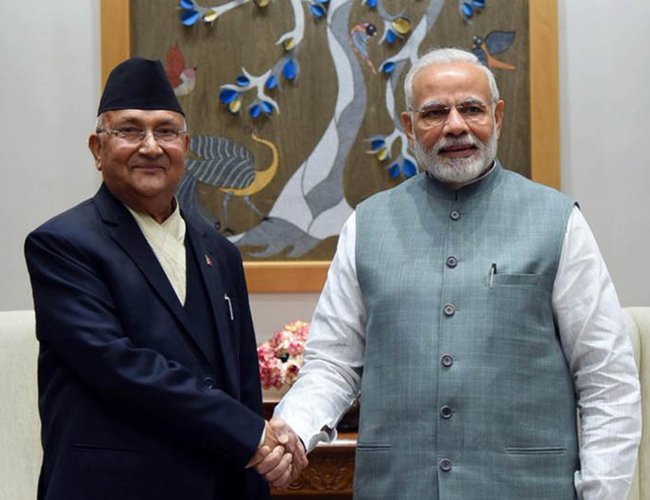English
Nepal: Implications Of Modi’s Upcoming Visit
The fact that India had been standing by Nepal all throughout the crisis of the 2015 earthquake and would keep doing so was ingeminated
- By
- Sohini Nayak
May 1, 2018, 7:33 a.m.

The contemporary India-Nepal ties have entered a new phase of interaction post the inception of the new government in Nepal, under Prime Minister K P Sharma Oli. At a time when the historical baggage of the 2015 Indo-Nepal blockade is still freshly etched in each other’s memories, a new path of negotiation has been probable on the cards. As found quoted by PM Oli himself, the bilateral ties between the two countries have evolved and metamorphosed according to the “needs of times” and would indulge in catering to long term goals of friendship.
This forward-looking approach is not only intrinsic to the advancement of connectivity issues and the impending cases of negotiation but also the bilateral conduciveness which is required for the overall prosperity of the region. This is all the more true in the presence of China and the all- weather friendship that it has begun sharing with Nepal, post the latter’s participation in the One Belt One Road (OBOR) initiative. Being the gigantic extra-regional actor that China is, such a notion is undoubtedly of great apprehension for India. With this growing closeness between the Himalayan kingdom and the Dragon state, in the Indo-centric locale, a new geostrategic power play is at existence.
In this backdrop, the recent bout of interaction between the two neighbour countries may be explained. Scheduled on 11 May, the visit of Prime Minister Narendra Modi to Nepal comes at the wake of the recent sojourn of the Foreign Minister of Nepal to China. After keeping up with the tradition of the first political visit to India, the next destination of Beijing could be well guessed. Though on a friendly note, the Chinese appreciation of the new federal structure of Nepal along with immense investments in line with the Belt and Road initiative (BRI) creates an open ended perception working.
Re-affirming negotiations
The focus of the newly formed coalition government in Nepal with the CPN-UML and Prime Minister Oli has been the implementation of the renewed foreign policy of ‘neighbourhood first’. In fact, China was also in praises for the independent and balanced foreign policy stance of the small buffer state. Though enveloped in constriction, China had also forwarded the idea of all the three countries- India, Nepal and itself- working towards achieving better comprehensive regional goals.
The maiden visit of K P Oli after assuming power may be regarded as the precursor to the visit of Modi in the month of May. This official invitation to Nepal can be perceived as an attempt to ease the calculative premonition associated with the previous encounter, just the other month. The foundation of this new visit has already been made through the earlier discussions of two-way engagement in defence and security, connectivity, trade and agriculture.
The fact that India had been standing by Nepal all throughout the crisis of the 2015 earthquake and would keep doing so was ingeminated. In a joint statement, both the Prime Ministers had addressed the all- inclusive development of a ‘prosperous and developed Nepal’ that would be in complete sync with “Sabkasaath Sabkavikaas” policy of the Indian government.
The inauguration of the integrated check post at Birgunj, Nepal was also a major success. With the core intention of enhancing connectivity and the operationalization of cross-border trade and transit of goods, a new horizon of integration opened up. Apart from the Motihari- Amkelhgunj cross-border petroleum pipeline at Motihari, Bihar, India was also substantiated.
Environmental concerns
However, the Arun-III hydropower project was found to be missing from the agenda of negotiations. The State Bank of India is supposedly investing INR 80 billion in this mega vision. When completed by the end of 2022, Nepal can massively enhance its hydro-power potential. But the project has attracted a lot of environmental concerns as well in both the nations, although previously endorsed as an achievement. In the next visit due in May, this issue can be addressed to harness an unbiased opinion from both the ends, for public welfare.
There were also extensive talks on partnership in agriculture. There may be a review on the Memorandum of understanding that has taken place between the two countries to promote and protect the agro-industry, the scientific community and the consumers as well. The one on one meeting was successful in its own right and has opened the new avenues of collaboration.
The augmentation and expansion of inland waterways has been a very recent development in the Indo-Nepal relations. The untapped potential of the region could be harnessed with the proper utilization of the inland waterways that could cohere with the prevailing geographic conditions. This would be a kind of an additional connectivity prospect. This is rotating around the India-Nepal Joint Working Group (JWG), which also facilitates the ongoing cross-border rail link projects. There are three other railway projects in the pipeline—New Jalpaiguri-Kakarbhitta, Nautanwa-Bhairahawa and Nepalgunj Road-Nepalgunj—and the leaders emphasized the importance of implementing the three remaining links.
China visit
One of the dominant existential issues for a country like Nepal is to bolster its foreign policy so as to gain maximum benefit for development. However, as for the new government, there is certainly a point of dilemma that PM Oli and his Foreign Ministry are caught up in. This asymmetric dependence is not to India’s satisfaction because of the left-leaning tendencies of the country towards China.
In this circumstance, the visit of Narendra Modi to China can bring about new assumptions and impressions in the Sino-Nepal as well as the Sino-Indian relationship. To be more precise, this visit has been planned between 27-28 April in Wuhan. Labelled as an “informal summit”, it has garnered a lot of curiosity. One of the noteworthy points is that Modi would be visiting China again, the very next month, again for the deliberations of the Shanghai Cooperation Organisation Summit.
There would also not be any agreements or joint statements made, just the plain but candid conversation. This has been named as the Modi-Xi Summit, which might have several bilateral and multilateral connotations. This visit will have a direct implication on the Indo-Nepal negotiations because it would be reflected in the meeting with Oli the next month as well.
The unique relationship between these three countries has a direct effect on the balancing capabilities of Nepal. If better negotiation can be established between China and India, Nepal will be in a better position of gaining investment and economic benefits from both the end along with a peaceful border. Thus, Modi’s visit brings with itself several important notions of future deliberations that can successfully generate a greater framework of working together, be it through the BBIN grouping or the access to South- East Asia through China.
(The writer is a Research Assistant at Observer Research Foundation, Kolkata)
Courtesy: Observer Research Foundation
This forward-looking approach is not only intrinsic to the advancement of connectivity issues and the impending cases of negotiation but also the bilateral conduciveness which is required for the overall prosperity of the region. This is all the more true in the presence of China and the all- weather friendship that it has begun sharing with Nepal, post the latter’s participation in the One Belt One Road (OBOR) initiative. Being the gigantic extra-regional actor that China is, such a notion is undoubtedly of great apprehension for India. With this growing closeness between the Himalayan kingdom and the Dragon state, in the Indo-centric locale, a new geostrategic power play is at existence.
In this backdrop, the recent bout of interaction between the two neighbour countries may be explained. Scheduled on 11 May, the visit of Prime Minister Narendra Modi to Nepal comes at the wake of the recent sojourn of the Foreign Minister of Nepal to China. After keeping up with the tradition of the first political visit to India, the next destination of Beijing could be well guessed. Though on a friendly note, the Chinese appreciation of the new federal structure of Nepal along with immense investments in line with the Belt and Road initiative (BRI) creates an open ended perception working.
Re-affirming negotiations
The focus of the newly formed coalition government in Nepal with the CPN-UML and Prime Minister Oli has been the implementation of the renewed foreign policy of ‘neighbourhood first’. In fact, China was also in praises for the independent and balanced foreign policy stance of the small buffer state. Though enveloped in constriction, China had also forwarded the idea of all the three countries- India, Nepal and itself- working towards achieving better comprehensive regional goals.
The maiden visit of K P Oli after assuming power may be regarded as the precursor to the visit of Modi in the month of May. This official invitation to Nepal can be perceived as an attempt to ease the calculative premonition associated with the previous encounter, just the other month. The foundation of this new visit has already been made through the earlier discussions of two-way engagement in defence and security, connectivity, trade and agriculture.
The fact that India had been standing by Nepal all throughout the crisis of the 2015 earthquake and would keep doing so was ingeminated. In a joint statement, both the Prime Ministers had addressed the all- inclusive development of a ‘prosperous and developed Nepal’ that would be in complete sync with “Sabkasaath Sabkavikaas” policy of the Indian government.
The inauguration of the integrated check post at Birgunj, Nepal was also a major success. With the core intention of enhancing connectivity and the operationalization of cross-border trade and transit of goods, a new horizon of integration opened up. Apart from the Motihari- Amkelhgunj cross-border petroleum pipeline at Motihari, Bihar, India was also substantiated.
Environmental concerns
However, the Arun-III hydropower project was found to be missing from the agenda of negotiations. The State Bank of India is supposedly investing INR 80 billion in this mega vision. When completed by the end of 2022, Nepal can massively enhance its hydro-power potential. But the project has attracted a lot of environmental concerns as well in both the nations, although previously endorsed as an achievement. In the next visit due in May, this issue can be addressed to harness an unbiased opinion from both the ends, for public welfare.
There were also extensive talks on partnership in agriculture. There may be a review on the Memorandum of understanding that has taken place between the two countries to promote and protect the agro-industry, the scientific community and the consumers as well. The one on one meeting was successful in its own right and has opened the new avenues of collaboration.
The augmentation and expansion of inland waterways has been a very recent development in the Indo-Nepal relations. The untapped potential of the region could be harnessed with the proper utilization of the inland waterways that could cohere with the prevailing geographic conditions. This would be a kind of an additional connectivity prospect. This is rotating around the India-Nepal Joint Working Group (JWG), which also facilitates the ongoing cross-border rail link projects. There are three other railway projects in the pipeline—New Jalpaiguri-Kakarbhitta, Nautanwa-Bhairahawa and Nepalgunj Road-Nepalgunj—and the leaders emphasized the importance of implementing the three remaining links.
China visit
One of the dominant existential issues for a country like Nepal is to bolster its foreign policy so as to gain maximum benefit for development. However, as for the new government, there is certainly a point of dilemma that PM Oli and his Foreign Ministry are caught up in. This asymmetric dependence is not to India’s satisfaction because of the left-leaning tendencies of the country towards China.
In this circumstance, the visit of Narendra Modi to China can bring about new assumptions and impressions in the Sino-Nepal as well as the Sino-Indian relationship. To be more precise, this visit has been planned between 27-28 April in Wuhan. Labelled as an “informal summit”, it has garnered a lot of curiosity. One of the noteworthy points is that Modi would be visiting China again, the very next month, again for the deliberations of the Shanghai Cooperation Organisation Summit.
There would also not be any agreements or joint statements made, just the plain but candid conversation. This has been named as the Modi-Xi Summit, which might have several bilateral and multilateral connotations. This visit will have a direct implication on the Indo-Nepal negotiations because it would be reflected in the meeting with Oli the next month as well.
The unique relationship between these three countries has a direct effect on the balancing capabilities of Nepal. If better negotiation can be established between China and India, Nepal will be in a better position of gaining investment and economic benefits from both the end along with a peaceful border. Thus, Modi’s visit brings with itself several important notions of future deliberations that can successfully generate a greater framework of working together, be it through the BBIN grouping or the access to South- East Asia through China.
(The writer is a Research Assistant at Observer Research Foundation, Kolkata)
Courtesy: Observer Research Foundation


